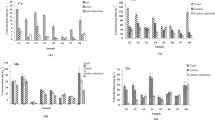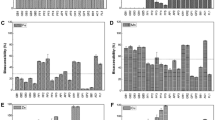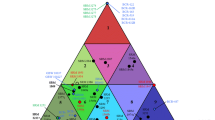Abstract
The consumption of fruits, vegetables, and cereals in the form of flour has been an alternative for the intake of nutrients, currently seen in a society that seeks a healthier diet. Thus, the assessment of total contents and bioaccessibility is important to better understand the actual intake of nutrients or contaminants present in foods. The objective of this study was to determine the total content and estimate the bioaccessible fraction of Cu, Fe, and Zn in nutritious flours by inductively coupled plasma optical emission spectrometry (ICP OES) after microwave acid digestion. Bioaccessibility was assessed using the in vitro method, taking into account the entire gastrointestinal tract (Unified Bioaccessibility Method (UBM)). The following concentration ranges, in μg g−1, were found: Ca (341–6275), K (2984–13,953), P (476–6110), Na (< 0.39–2995), Fe (1.4–167), Cu (< 0.01–59.6), and Zn (< 0.07–30.3). Principal component analysis (PCA) and hierarchical cluster analysis (HCA) showed a tendency towards the formation of three groups. The bioaccessible fractions for Cu, Fe, and Zn were considered low, ranging from 0.96 to 40% in the gastrointestinal phase and from 4.1 to 100% in the gastric phase.


Similar content being viewed by others
Data Availability
Datasets generated during and/or analyzed during the current study are not publicly available as the data are not public, but are available from the corresponding author upon reasonable request.
References
Abuajah CI, Ogbonna AC, Osuji CM (2015) Functional components and medicinal properties of food: a review. J Food Sci Technol 52(5):2522–2529. https://doi.org/10.1007/s13197-014-1396-5
Betoret E, Betoret N, Vidal D, Fito P (2011) Functional foods development: trends and technologies. Trends Food Sci Technol 22(9):498–508. https://doi.org/10.1016/j.tifs.2011.05.004
Khouzam RB, Pohl P, Lobinski R (2011) Bioaccessibility of essential elements from white cheese bread fruit and vegetables. Talanta 86:425–428. https://doi.org/10.1016/j.talanta.2011.08.049
Brasil (2005) Ministry of Health / National Health Surveillance Agency (ANVISA), Resolution-RDC Nº 263 of September 22, Technical Regulation for Cereal Products, Starches. Flours and Bran
Ferreira MS, Santos MC, Moro TM, Basto GJ, Andrade RM, Gonçalves EC (2015) Formulation and characterization of functional foods based on fruit and vegetable residue flour. J Food Sci Technol 52(2):822–830. https://doi.org/10.1007/s13197-013-1061-4
Cozzolino SMF (2005) Biodisponibilidade de nutrientes. 2ª edição, Editora Manole
Ruby MV, Schoof R, Brattin W, Goldade M, Post G, Harnois M, Chappell W (1999) Advances in evaluating the oral bioavailability of inorganics in soil for use in human health risk assessment. Environ Sci Technol 33(21):3697–3705. https://doi.org/10.1021/es990479z
Fernández-García E, Carvajal-Lérida I, Pérez-Gálvez A (2009) In vitro bioaccessibility assessment as a prediction tool of nutritional efficiency. Nutr Res 29(11):751–760. https://doi.org/10.1016/j.nutres.2009.09.016
Lucas-González R, Viuda-Martos M, Pérez-Alvarez JA, Fernández-López J (2018) In vitro digestion models suitable for foods: opportunities for new fields of application and challenges. Food Res Int 107:423–436. https://doi.org/10.1016/j.foodres.2018.02.055
Minekus M, Alminger M, Alvito P, Balance S, Bohn TORSTEN, Bourlieu C, Dufour C (2014) A standardised static in vitro digestion method suitable for food–an international consensus. Food Funct 5(6):1113–1124. https://doi.org/10.1039/c3fo60702j
Herrera MA, Rosende M, Arruda MAZ, Miró M (2016) On-line coupling of physiologically relevant bioaccessibility testing to inductively coupled plasma spectrometry: Proof of concept for fast assessment of gastrointestinal bioaccessibility of micronutrients from soybeans. Anal Chim Acta 939:1–9. https://doi.org/10.1016/j.aca.2016.07.030
Wragg J, Cave M, Basta N, Brandon E, Casteel S, Denys S, Van de Wiele T (2011) An inter-laboratory trial of the unified BARGE bioaccessibility method for arsenic, cadmium and lead in soil. Sci Total Environ 409(19):4016–4030
Tokalıoğlu Ş, Clough R, Foulkes M, Worsfold P (2014) Bioaccessibility of Cr, Cu, Fe, Mg, Mn, Mo, Se and Zn from nutritional supplements by the unified BARGE method. Food Chem 150:321–327. https://doi.org/10.1016/j.foodchem.2013.10.151
De Lima ACS, Soares DJ, da Silva LMR, de Figueiredo RW, de Sousa PHM, de Abreu ME (2014) In vitro bioaccessibility of copper, iron, zinc and antioxidant compounds of whole cashew apple juice and cashew apple fibre (Anacardium occidentale L.) following simulated gastro-intestinal digestion. Food Chem 161:142–147. https://doi.org/10.1016/j.foodchem.2014.03.123
da Silva EDN, Heerdt G, Cidade M, Pereira CD, Morgon NH, Cadore S (2015) Use of in vitro digestion method and theoretical calculations to evaluate the bioaccessibility of Al, Cd, Fe and Zn in lettuce and cole by inductively coupled plasma mass spectrometry. Microchem J 119:152–158. https://doi.org/10.1016/j.microc.2014.12.002
Herrera-Agudelo MA, Miró M, Arruda MA (2017) In vitro oral bioaccessibility and total content of Cu, Fe, Mn and Zn from transgenic (through cp4 EPSPS gene) and nontransgenic precursor/successor soybean seeds. Food Chem 225:125–131. https://doi.org/10.1016/j.foodchem.2017.01.017
Menezes EA, Oliveira AF, França CJ, Souza GB, Nogueira ARA (2018) Bioaccessibility of Ca, Cu, Fe, Mg, Zn and crude protein in beef pork and chicken after thermal processing. Food Chem 240:75–83. https://doi.org/10.1016/j.foodchem.2017.07.090
Santana FB, Souza LA, Carvalho WC, Korn MGA, Santos DCMB (2020) Determination and In Vitro Bioaccessibility Evaluation of Cu, Fe, Mn, and Zn in Chia (Sa lvia hispanica L.) seeds by ICP OES. Food Anal Methods 13(1):176–185. https://doi.org/10.1007/s12161-019-01564-x
Tokalıoğlu Ş (2022) Bioaccessibility of Cu, Mn, Fe, and Zn in fruit and vegetables by the in vitro UBM and statistical evaluation of the results. Biol Trace Elem Res 1–9. https://doi.org/10.1007/s12011-022-03253-z
Szymczycha-Madeja A, Welna M, Pohl P (2020) Simplified method of multi-elemental analysis of dialyzable fraction of tea infusions by FAAS and ICP OES. Biol Trace Elem Res 195(1):272–290. https://doi.org/10.1007/s12011-019-01828-x
Algül I, Kara D (2014) Determination and chemometric evaluation of total aflatoxin, aflatoxin B1, ochratoxin A and heavy metals content in corn flours from Turkey. Food Chem 157:70–76. https://doi.org/10.1016/j.foodchem.2014.02.004
Brito ALB, Oliveira AF, Nogueira ARA, Pessoa AG, Pontes LF (2017) Determination of inorganic constituents and physicochemical characterization of functional flour samples. Microchem J 132:112–118. https://doi.org/10.1016/j.microc.2017.01.017
Ho LH, Abdul Latif NWB (2016) Nutritional composition, physical properties, and sensory evaluation of cookies prepared from wheat flour and pitaya (Hylocereus undatus) peel flour blends. Cogent Food Agric 2(1):1136369. https://doi.org/10.1080/23311932.2015.1136369
Chauhan A, Saxena DC, Singh S (2016) Physical, textural, and sensory characteristics of wheat and amaranth flour blend cookies. Cogent Food & Agriculture 2(1):1125773. https://doi.org/10.1080/23311932.2015.1125773
Souza LA, Souza TL, Santana FB, Araujo RGO, Teixeira LSG, Santos DCMB, Korn MGA (2018) Determination and in vitro bioaccessibility evaluation of Ca, Cu, Fe, K, Mg, Mn, Mo, Na, P and Zn in linseed and sesame. Microchem J 137:8–14. https://doi.org/10.1016/j.microc.2017.09.010
Wragg J, Cave M, Taylor H, Basta N, Brandon E, Casteel S, Gron C, Oomen A, Van de Wiele T (2009) Inter-laboratory trial of a unified bioaccessibility testing procedure. British Geological Survey, Nottingham, UK
BRAZIL (2017) Ministry of Health / National Health Surveillance Agency (ANVISA). Resolution nº 166 of July 24, Provides for the validation of methods analytical
Mermet JM, Poussel E (1995) ICP emission spectrometers: 1995 analytical figures of merit. Appl Spectrosc 49(10):12A-18A
FDA - Food and Drug Administration (2016) https://www.fda.gov/media/99069/download. Accessed 12.02.2020
Singh P, Prasad S (2018) Determination of ascorbic acid and its influence on the bioavailability of iron, zinc and calcium in Fijian food samples. Microchem J 139:119–124. https://doi.org/10.1016/j.microc.2018.02.019
Talpur S, Afridi HI, Kazi TG, Talpur FN (2018) Interaction of lead with calcium, iron, and zinc in the biological samples of malnourished children. Biol Trace Elem Res 183(2):209–217. https://doi.org/10.1007/s12011-017-1141-9
Skibsted LH (2016) Mineral nutrient interaction: improving bioavailability of calcium and iron. Food Sci Biotechnol 25(5):1233–1241. https://doi.org/10.1007/s10068-016-0196-2
Bost M, Houdart S, Oberli M, Kalonji E, Huneau JF, Margaritis I (2016) Dietary copper and human health: current evidence and unresolved issues. J Trace Elem Med Biol 35:107–115. https://doi.org/10.1016/j.jtemb.2016.02.006
Myint ZW, Oo TH, Thein KZ, Tun AM, Saeed H (2018) Copper deficiency anemia. Ann Hematol 97(9):1527–1534. https://doi.org/10.1007/s00277-018-3407-5
Horn N, Møller LB, Nurchi VM, Aaseth J (2019) Chelating principles in Menkes and Wilson diseases: choosing the right compounds in the right combinations at the right time. J Inorg Biochem 190:98–112. https://doi.org/10.1016/j.jinorgbio.2018.10.009
Bjørklund G, Aaseth J, Skalny AV, Suliburska J, Skalnaya MG, Nikonorov AA, Tinkov AA (2017) Interactions of iron with manganese. zinc. chromium. and selenium as related to prophylaxis and treatment of iron deficiency. J Trace Elem Med Biol 41:41–53. https://doi.org/10.1016/j.jtemb.2017.02.005
Rout GR, Sahoo S (2015) Role of iron in plant growth and metabolism. Rev Agric Sci 3:1–24. https://doi.org/10.7831/ras.3.1
Pohl HR, Wheeler JS, Murray HE (2013) Sodium and potassium in health and disease. In Interrelations between essential metal and human diseases. Springer Dordrecht, p 29–47. https://doi.org/10.1007/978-94-007-7500-8_2
Dermience M, Lognay G, Mathieu F, Goyens P (2015) Effects of thirty elements on bone metabolism. J Trace Elem Med Biol 32:86–106. https://doi.org/10.1016/j.jtemb.2015.06.005
Word Health Organization – WHO. Reducing salt intake populations: report of a WHO forum and technical meeting. Paris, 2006
Machado RMA, Serralheiro RP (2017) Soil salinity: effect on vegetable crop growth. Management practices to prevent and mitigate soil salinization. Horticulturae 3(2):30. https://doi.org/10.3390/horticulturae3020030
Brazil (2009) Brazilian Agricultural Research Corporation (EMBRAPA). Manual of chemical analysis of soils, plants and fertilizers, 2 edn. Embrapa Informação Tecnológica, Brasília-DF
Versantvoort CH, Oomen AG, Van de Kamp E, Rompelberg CJ, Sips AJ (2005) Applicability of an in vitro digestion model in assessing the bioaccessibility of mycotoxins from food. Food Chem Toxicol 43(1):31–40. https://doi.org/10.1016/j.fct.2004.08.007
Oomen AG, Hack A, Minekus M, Zeijdner E, Cornelis C, Schoeters G, Sips AJ (2002) Comparison of five in vitro digestion models to study the bioaccessibility of soil contaminants. Environ Sci Technol 36(15):3326–3334. https://doi.org/10.1021/es010204v
Schümann K, Classen HG, Dieter HH, König J, Multhaup G, Rükgauer M, Biesalski HK (2002) Hohenheim consensus workshop: copper. Eur J Clin Nutr 56(6):469–483. https://doi.org/10.1038/sj.ejcn.1601315
Hurrell R, Egli I (2010) Iron bioavailability and dietary reference values. Am J Clin Nutr 91(5):1461S-1467S. https://doi.org/10.3945/ajcn.2010.28674f
de Oliveira AP, Mateó BDSO, Fioroto AM, de Oliveira PV, Naozuka J (2018) Effect of cooking on the bioaccessibility of essential elements in different varieties of beans (Phaseolus vulgaris L.). J Food Compos Anal 67:135–140. https://doi.org/10.1016/j.jfca.2018.01.012
Cook JD, Monsen ER (1976) Food iron absorption in human subjects. III. Comparison of the effect of animal proteins on nonheme iron absorption. Am J Clin Nutr 29(8):859–867. https://doi.org/10.1093/ajcn/29.8.859
Mafra D, Cozzolino SMF (2004) Importância do zinco na nutrição humana. Rev Nutr 17(1):79–88. https://doi.org/10.1590/S1415-52732004000100009
Szymczycha-Madeja A, Welna M, Pawel P (2015) Solubility and bioaccessibility of Ba, Ca, Cr, Cu, Fe, Mg, Mn, P, Sr and Zn in slim coffee infusions by in vitro gastrointestinal digestion. J Braz Chem Soc 26(9):1781–1789. https://doi.org/10.5935/0103-5053.20150154
Ferreira MP, Tarley CRT (2020) Assessment of in vitro bioacessibility of macrominerals and trace elements in green banana flour. J Food Compos Anal 92:103586. https://doi.org/10.1016/j.jfca.2020.103586
Funding
The authors are grateful for the infrastructure, scholarships, and financial resources for research provided by Fundação de Amparo à Pesquisa do Estado da Bahia (FAPESB, Salvador, Brazil) and Conselho Nacional de Desenvolvimento Científico e Tecnológico (CNPq, Brasília, Brazil). This study was also financed in part by Coordenação de Aperfeiçoamento de Pessoal de Nível Superior – Brasil (CAPES, Brasília, Brazil) – Finance Code 001.
Author information
Authors and Affiliations
Contributions
Thaís L. Souza: Conceptualization. Resources. Experimental data acquisition. Methodology. Validation. Formal analysis. Writing. Review and editing. Laís A. Souza: Conceptualization. Resources. Experimental data acquisition. Supervision. Writing. Review and editing. Isa S. Barbosa: Conceptualization. Resources. Experimental data acquisition. Spectral measurement. Daniele Cristina M. B. Santos: Conceptualization. Resources. Funding acquisition. Supervision. Writing. Review and editing. Rennan Geovanny O. Araujo: Conceptualization. Resources. Writing. Review and editing. Maria Graças A. Korn: Conceptualization. Data curation. Funding acquisition. Supervision. Writing – original draft. Writing – review & editing.
Corresponding author
Ethics declarations
Competing Interests
The authors declare no competing interests.
Additional information
Publisher's Note
Springer Nature remains neutral with regard to jurisdictional claims in published maps and institutional affiliations.
Rights and permissions
Springer Nature or its licensor (e.g. a society or other partner) holds exclusive rights to this article under a publishing agreement with the author(s) or other rightsholder(s); author self-archiving of the accepted manuscript version of this article is solely governed by the terms of such publishing agreement and applicable law.
About this article
Cite this article
Souza, T.L., Souza, L.A., Barbosa, I.S. et al. Mineral and Trace Elements in Nutritious Flours: Total Contents, In Vitro Bioaccessibility and Contribution to Dietary Intake. Biol Trace Elem Res 201, 4600–4611 (2023). https://doi.org/10.1007/s12011-022-03534-7
Received:
Accepted:
Published:
Issue Date:
DOI: https://doi.org/10.1007/s12011-022-03534-7




